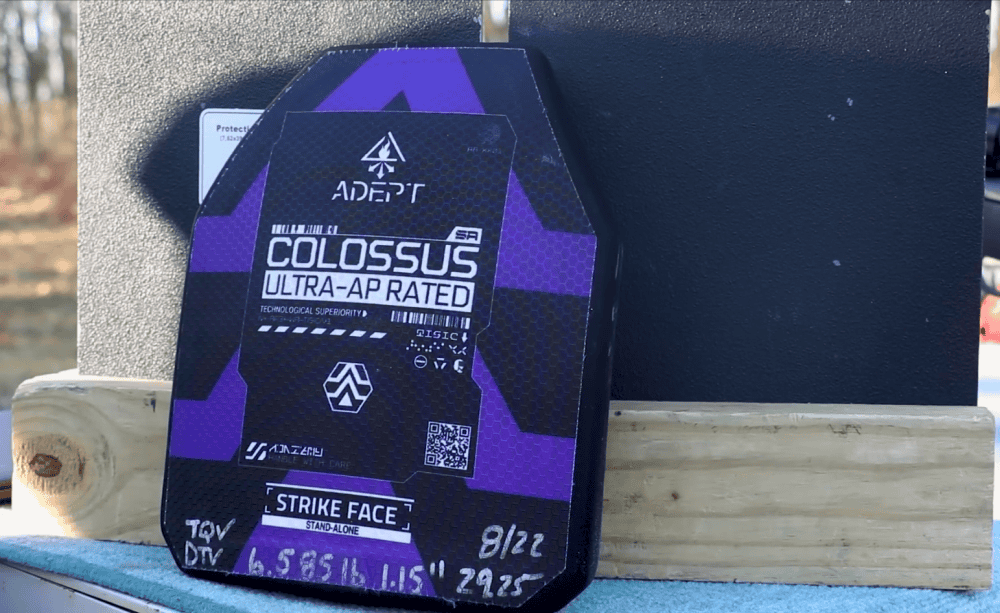
[Image above] Example of a ceramic armor plate by Adept Armor. Developing new ceramic armor materials may be easier with the help of a recently proposed predictive model. Credit: Buffman – R.A.N.G.E., YouTube
In the recent Disney+ historical fantasy series Renegade Nell, the help of a plucky little sprite is the only way to effectively stop bullets in 18th century England. But in current times, our protection from ballistics is much less magical and instead can rely on the power of ceramics.
The first indication that ceramics may be beneficial for ballistic protection came in 1918, when British Army Major Neville Monroe Hopkins discovered that a thin layer of hard enamel (1–2 millimeters) improved the penetration resistance of a thin steel plate.
Some isolated innovations involving ceramic vehicle armor were reported in the following decades, such as by the U.S. military during the Korean War (1950s). But it was the introduction of ceramic body armor for helicopter crew during the Vietnam War (1960s) that really kicked off research on modern ceramic armor systems.
Most ceramic armor systems today consist of a ceramic tile backed by a ductile fiber reinforced plastic composite or metal layer. Alumina, silicon carbide, and boron carbide are the ceramics most commonly used.
Despite the long history and widespread use of ceramic armor, development of ceramic armor materials remains surprisingly constrained. This struggle is due to a lack of understanding of the nontrivial and nuanced behaviors of ceramic materials under high-speed impact, particularly in terms of crack propagation and material fragmentation at very high strain rates.
In July 2023, the International Journal of Applied Ceramic Technology curated a special collection of articles highlighting recent attempts to develop measures for bettering qualifying ceramic armor performance under ballistic conditions. But as with other experimental approaches, these methods run up against the limitations of existing predictive models.
The traditional predictive method in ceramic body armor design and material selection is computational modeling with finite element models (FEMs). FEMs are highly dependent on the accuracy of the input parameters, and so are better suited for analyzing existing configurations than predicting the performance of novel materials or untested combinations.
However, even for existing ceramic armor systems, the relationship between a ceramic material’s mechanical properties and its ballistic efficacy remains imperfectly understood on a theoretical level.
As such, “FEMs do not provide a way to predict performance from mechanical properties of a given material or material combination in a straightforward and comprehensible way,” writes Jake Ganor in a recent open-access article.
Ganor is founder and CEO of Adept Armor (Tulsa, Okla.), a company that develops materials for adaptive body armor systems and personal protective gear. In his article, he proposes a new formula for predicting ballistic efficacy of ceramic materials, which he devised based on insights gleaned from developing silicon carbide and boron carbide armor systems.
“… the author of this paper has noticed that a 7.8 mm thickness of sintered SiC will perform exactly as well as an 8.3 mm thickness of sintered B4C against a steel-cored AP [armor piercing ammunition] threat when used in conjunction with an energy-absorbing backing layer made of UHMWPE [ultrahigh-molecular-weight polyethylene],” Ganor writes.
Thus, material density “cannot be the only thing that matters,” Ganor states, as suggested by the pioneering work of M.L. Wilkins and his associates at Lawrence Livermore National Laboratory on ceramic armor systems in the late 1960s and early 1970s.
To determine which other material properties contribute to ballistic efficacy, Ganor laid out the mechanical properties of several ceramic armor materials and then construed a series of downstream relations that linked those properties to their performance characteristics. Fitting these results to existing experimental data in an iterative process, Ganor derived the following equation:

where BE is ballistic efficacy, D is density (g/cm3), CS is compressive strength (MPa), T is thickness (mm), and H is Vickers hardness. The constants—1.677, 0.003, and 0.005—were derived from regression analysis.
Notably, quasi-static rather than dynamic compressive strength is used in this equation. As Ganor explains, “Dynamic CS need not be considered, for it has been shown that the CS of strong ceramics is strain rate–dependent and increases in a predictable way at increasing strain rates. Therefore, quasi-static strength is predictive of dynamic strength in ceramic armor materials.”
For context on how BE values relate to real-world situations, materials with a BE value of approximately 70 can defeat 0.30–06 M2 armor piercing ammunition in a typical light body armor or vehicular armor system. Meanwhile, materials with a BE value of approximately 100 can defeat 0.50 Browning machine gun armor piercing ammunition in a light armor system.
Ganor validated the equation using in-house test data, historical experimental data from Wilkins’ work at Lawrence Livermore National Laboratory, as well as separate test data provided by Erik Carton’s group at TNO, the Dutch Organization for Applied Scientific Research.
Following this validation, Ganor states that “this new formula addresses the inaccuracies associated with previous equations, accurately and very rapidly assesses common armor ceramic types, and has sufficient explanatory power to resolve relations between materials that had seemed paradoxical.”
As such, “This advance is a significant step toward optimizing existing materials and exploring new ones, and it may light the path to more effective armor systems,” he concludes.
The open-access paper, published in International Journal of Ceramic Engineering & Science, is “A facile method for the estimation of ceramic performance in light armor systems” (DOI: 10.1002/ces2.10227).
